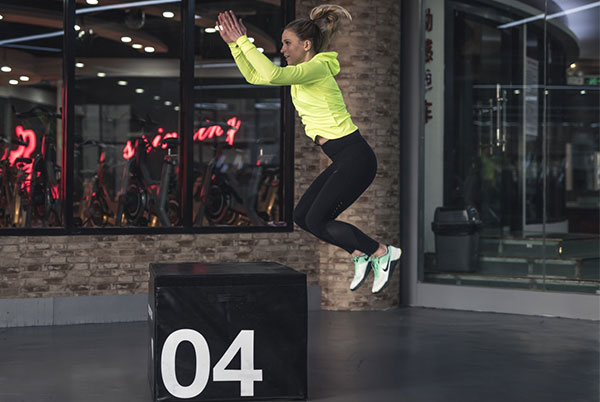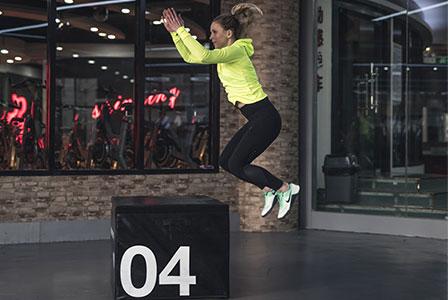
You might be well aware of the fact that supplementary training can help runners big time. From injury prevention to performance improvement, scientific studies have proven it over and over again.
Plyometrics is one such training that can work wonders for you as a runner.
Just a few minutes of plyometric training each week and your chances of improvement increase tremendously.
Let’s take a look at the benefits of plyometrics and how to do it properly. Additionally, I have listed 6 plyometric exercises at the end of the post.
Let’s jump right in!
What is plyometrics?
Plyometrics, also known as jump training or plyos, is explosive strength training which involves body weight jumping and bounding type exercises. This type of training is highly effective in increasing explosive strength.

A plyometric training session simply is a series of jumping, hopping and bounding exercises.
If you think about running, it’s basically a series of landing on the ground and bouncing off of it. And plyometric exercises are simply the exaggerated form of running.
Is plyometrics good for runners?
You may have seen sprinters and power athletes doing those cool plyometric exercises, but the question is – are they any good for distance runners?
According to several studies – Yes.
Not only road runners, but trail runners can get significant advantages from plyometric training.
Let’s take a look at the key benefits of plyometrics for runners:
Improved Speed
Plyometric training trains your body to spend less time on the ground which is an important trait of faster runners. This also helps you use more stored energy with each foot strike as you accelerate into the next one.
A study of seventeen male runners proved that plyometrics improves running performance. These seventeen runners were randomly split into two groups. While one group trained normally, the experimental group completed 6-week plyometric training in addition to their normal training.
Following the training period, a significant improvement of 2.7% in their 3-k performance was recorded.
The important thing to note here is – the subjects of this experiment were elite runners. For elite runners, a 2.7% performance improvement is huge because at their level it’s really hard to achieve the smallest improvements.
So think about what beginner runners can achieve from such training.
Improved Running Economy
There are several factors that can contribute to performance improvement.
Plyometrics improves your running technique and running economy. And these may be the other factors why your speed is improved.
A study of fifteen highly-trained middle and long-distance runners supports this claim. This study was conducted with a group of fifteen runners who undertook 3 x 30 minutes of plyometric sessions per week for 9 weeks.
Improved Strength
Plyometric training also gives you the next level strength. Your muscle fibers get stronger and more flexible by stretching and contracting.
Strength and plyometric training teach the body to better coordinate muscle contractions, which help movements become more efficient.
Your muscle stiffness also increases (not in a negative way) which increases the amount of elastic energy that is stored and used during each stride. This makes your every stride more powerful and you also spend less energy.
So, in addition to strength training, doing plyometrics can make you super strong.
Injury Prevention
When you run, your body has to absorb the shock generated by your feet striking the ground.
If your body can’t handle this shock efficiently, your chances of getting injured increase tremendously.
Plyometric training helps big time in this regard. Your body learns to absorb the shock efficiently. Your muscles learn to activate more readily. Your muscles, tendons, and ligaments don’t overstretch.
As a result, you become a stronger runner – less likely to get injured.
Note – Plyometric exercises are quite intense and the moves require you to be quick and explosive. You need to be in good shape to be able to perform them. If you’re not in a good shape yet, do strength training first. As you get stronger then introduce plyometrics into your training.
Should distance runners do plyometrics?
Absolutely!
As noted above, scientific studies have proven that distance runners can benefit from plyometric exercises in several ways. We know that it would be a challenge to include additional training for distance runners as they have to spend a lot of time running. And if you add a few strength training sessions, you might find it hard to allocate some time for Plyometrics.
But here is the best part – you don’t have to spend a lot of time doing plyometric training. 10-20 minute plyometric sessions twice a week is enough to gain the amazing benefits.
So the fact that you don’t need a lot of time to perform plyometric exercises and realizing all the benefits you can get, it’s totally worth your time.
When and how often should you do plyometric exercises?
While you should perform strength training on your hard days, following the philosophy of keeping your hard days hard and easy days easy.
Plyometrics should not be done on your hard days or even the day after a hard workout.
The reason is if you do it on your hard days or even the day after, your risk of getting injured increases. Plyometric exercises are intense and they shouldn’t be performed with fatigued muscles.
So when should you do it then?
Perform your plyometric training on recovery days or your easy run days.
Also, do not perform plyometrics more than twice a week. And keep a gap of at least 48 hours between two plyo sessions.
What are the best plyometric exercises?
Now, we know how beneficial plyometrics can be for distance runners, here are the six best exercises.
But let’s take a look at some important things to note before you start:
- Make sure you maintain good form while performing these exercises.
- Try to spend as little time on the ground as possible. The explosive nature of plyometrics is what makes it so effective.
- Rest 1-2 minutes between each set. you need proper recovery to gain the maximum benefits and avoid injuries.
Now it’s time to look at the exercises. I have divided them into two groups – jumping and bounding.
Jumping exercises
Vertical Jump
Stand with your feet shoulder-width apart. Jump upward and land on the balls of your feet at the same spot you jumped from. And then immediately jump again. Bend your knees as little as possible throughout this exercise.
Jump Lunge
Stand with your feet shoulder-width apart. Jump into the air, moving one leg in front of your body and the other leg behind. Land in a lunge position. Immediately jump again switching the legs midair.
Drop Jump
Stand on top of a sturdy platform. Jump off and land on the ground with both your feet. Immediately jump back up on the platform.
Use a 20 to 40 cm high platform. If the platform you use is higher, it’ll work more on strength, and if the platform is lower, it’ll work on speed.
Side-to-side jump
Stand with your feet closer to each other. Place an object like an agility cone or something else on your right side. Jump to the right side over the cone and land on the balls of your feet. Then immediately jump back to the left side. That’s two reps.
Note: If you are just starting out, use a smaller object with less height. As you get comfortable you can use a bigger object.
Box jump
Begin by standing with your feet shoulder-width apart just behind a box or something sturdy.
Jump with both your feet onto the box. You should land on the balls of your feet on top of the box. And then immediately jump back down to the ground to complete the rep.
As you get experienced with this exercise, you can progress on to Single Leg Box Jump. Single leg box jump is simply performed with one leg at a time in the same manner.
Again, begin with a smaller box and use a bigger box once you get comfortable.
Bounding exercises:
You’ll need to go outdoors to perform these exercises. A playground would be the best place.
Double leg bound 2 x 10
From a squat position, jump forward with both your legs as far as you can. Keep jumping forward until the recommended number of reps are completed.
When you are comfortable with double leg bound, progress to single leg bound. Perform single leg bound with standing on one of your legs, jump up and forward and land on the same leg. Complete the recommended reps and then repeat with the other leg.
Alternating-leg bound 2 x 10
Standing on your right leg, jump up and forward. Once you’re in the air bring your left leg forward and prepare to land on your left foot. Immediately, push off with the left leg and land on the right leg.
Are these exercises too difficult for you?
If they are, you can decrease the workload by starting with only 2-3 exercises. You can also reduce the number of reps and start with as low as 5 reps.
As you get stronger, gradually increase the number of reps. And later on, include more exercises to your plyometric routine. But don’t overdo it. As noted above, a 15-20 minute plyo session is enough to reap the benefits. Limit your plyo session to 30 minutes maximum.
So a sample workout for beginners may look like this:
- Vertical Jump 2 x 10
- Jump Lunge 2 x 10
- Drop Jump 2 x 10
Additional Resources:
- Plyometrics. webmd.
- Should Endurance Athletes Do Plyometric Training? TrainingPeaks.

